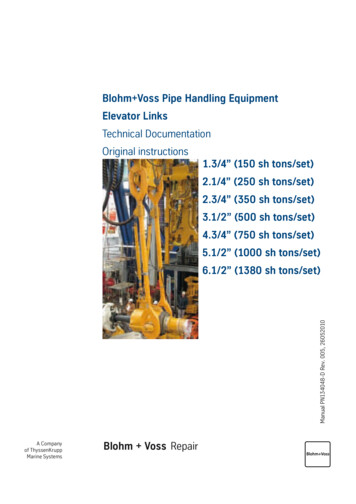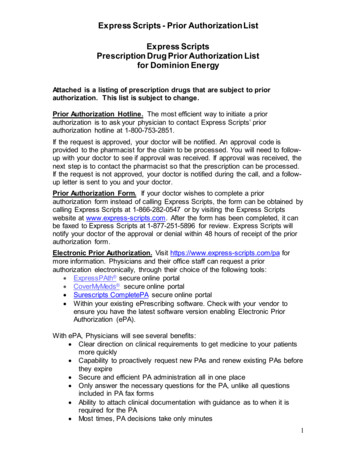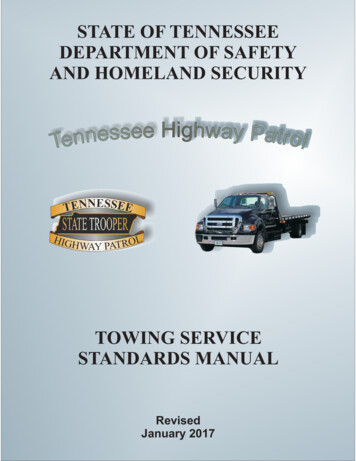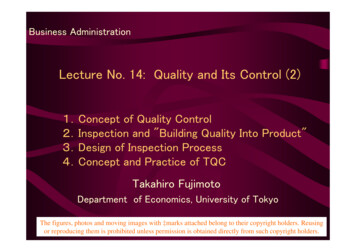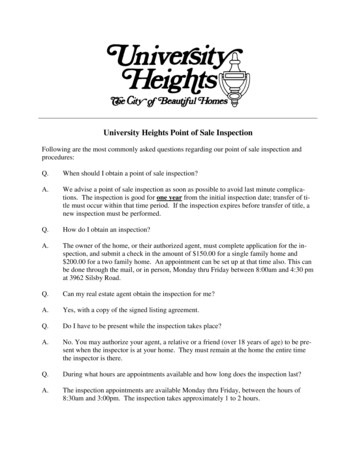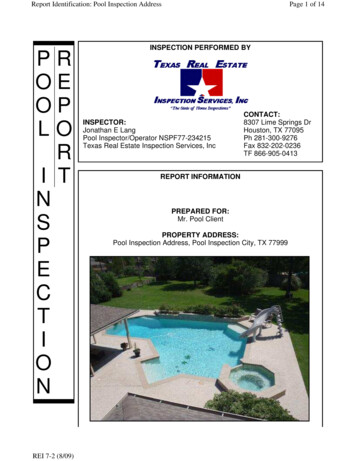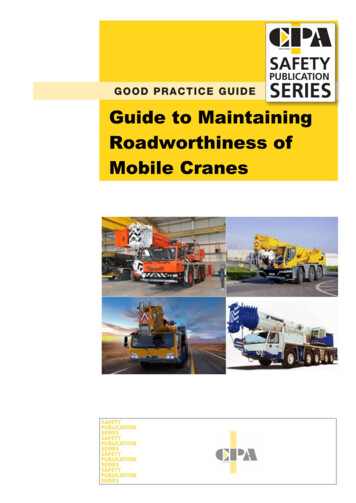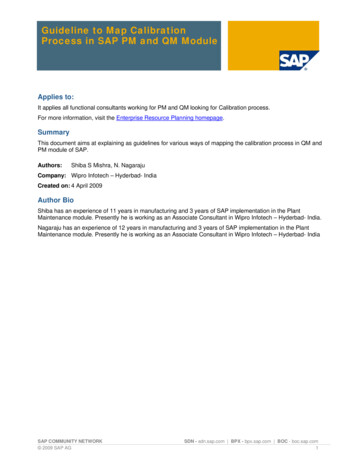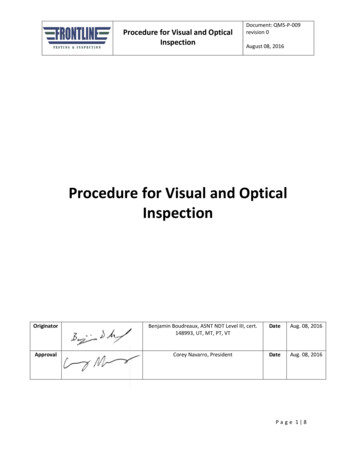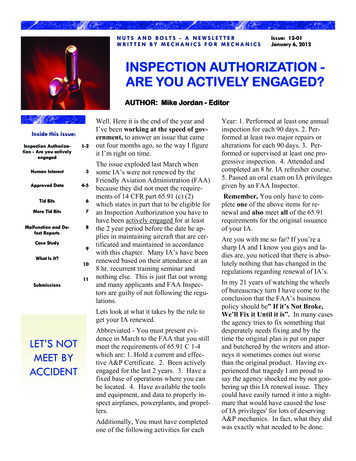
Transcription
NUTS AND BOLTS - A NEWSLETTERWRITTEN BY MECHANICS FOR MECHANICSIssue: 12-01January 6, 2012INSPECTION AUTHORIZATION ARE YOU ACTIVELY ENGAGED?AUTHOR: Mike Jordan - EditorInside this issue:Inspection Authorization - Are you activelyengaged1-2Human Interest3Approved Data4-5Tid Bits6More Tid Bits7Malfunction and Defect Reports8Case StudyWhat Is It?Submissions91011Well. Here it is the end of the year andI’ve been working at the speed of government, to answer an issue that cameout four months ago, so the way I figureit I’m right on time.The issue exploded last March whensome IA’s were not renewed by theFriendly Aviation Administration (FAA)because they did not meet the requirements of 14 CFR part 65.91 (c) (2)which states in part that to be eligible foran Inspection Authorization you have tohave been actively engaged for at leastthe 2 year period before the date he applies in maintaining aircraft that are certificated and maintained in accordancewith this chapter. Many IA’s have beenrenewed based on their attendance at an8 hr. recurrent training seminar andnothing else. This is just flat out wrongand many applicants and FAA Inspectors are guilty of not following the regulations.Lets look at what it takes by the rule toget your IA renewed.LET’S NOTMEET BYACCIDENTAbbreviated - You must present evidence in March to the FAA that you stillmeet the requirements of 65.91 C 1-4which are: 1. Hold a current and effective A&P Certificate. 2. Been activelyengaged for the last 2 years. 3. Have afixed base of operations where you canbe located. 4. Have available the toolsand equipment, and data to properly inspect airplanes, powerplants, and propellers.Additionally, You must have completedone of the following activities for eachYear: 1. Performed at least one annualinspection for each 90 days. 2. Performed at least two major repairs oralterations for each 90 days. 3. Performed or supervised at least one progressive inspection. 4. Attended andcompleted an 8 hr. IA refresher course.5. Passed an oral exam on IA privilegesgiven by an FAA Inspector.Remember, You only have to complete one of the above items for renewal and also meet all of the 65.91requirements for the original issuanceof your IA.Are you with me so far? If you’re asharp IA and I know you guys and ladies are, you noticed that there is absolutely nothing that has changed in theregulations regarding renewal of IA’s.In my 21 years of watching the wheelsof bureaucracy turn I have come to theconclusion that the FAA’s businesspolicy should be” If it’s Not Broke,We’ll Fix it Until it is”. In many casesthe agency tries to fix something thatdesperately needs fixing and by thetime the original plan is put on paperand butchered by the writers and attorneys it sometimes comes out worsethan the original product. Having experienced that tragedy I am proud tosay the agency shocked me by not goobering up this IA renewal issue. Theycould have easily turned it into a nightmare that would have caused the loseof IA privileges' for lots of deservingA&P mechanics. In fact, what they didwas exactly what needed to be done.
Nuts And Bolts - A Newsletter Written By Mechanics ForMechanicsISSUE: 12-01Page 2ARE YOU ACTIVELY ENGAGED? - continuedThey revised the FAA Inspectors guidance. FAAOrder 8900.1, Vol. 5, Chap. 5. They did this because there was never anything wrong with therule, the problem was that the term actively engaged was too ambiguous for FAA Inspectors toapply properly and consistently across the country. Believe it or not FAA Inspectors are nothatched out of a single mold in Oklahoma City,each one is a unique individual with different andvarying backgrounds and experiences. So, to fixthe problem the FAA gave us a little more guidance including some examples of what they consider actively engaged. However, in the processthey clearly left it up to the Inspector to make thedecision on that little part about actively engaged.Isn't that a new concept!! Hire Inspectors withextensive experience and backgrounds so theycan make intelligent and rational decisions andthen let them make decisions all by their selves.Wow, what will they think of next.Here is some good information that came out inthe NPRM that’s worth saving: Actively Engaged means: an active role in exercising theprivileges of an airframe and powerplant mechanic certificate in the maintenance of civil aircraft. Applicants who inspect, overhaul, repair,preserve, or replace parts on aircraft or who supervise (i.e. direct and/or inspect) those activitesare actively engaged. Technical instructors orpeople that instruct at a FAA part 147 AMTschool are also considered actively engaged.IA’s that are employed in a position that does notrequire a tool box flash light and mirror need tobe prepared to show the FAA Inspector proof thatyou are actively engaged. That proof might be inthe form of employment records showing performance or supervision of aircraft maintenance,return to service documents, and or copies ofmaintenance record entries.More good things to know about IA renewal: None of the requirements of 14 CFR part 65.91(C) 1-4 May be waived by an Aviation Safety Inspector. The Inspector may contact the applicantsemployer to verify the part 65.91 requirements The number of annual inspections and/or majorrepairs or alterations may not be mixed. If you use an eight hour recurrent training courseto renew you must provide proof of attendance. If you did not have enough activity and did notattend a renewal course you must subject yourself toan oral exam with an FAA Inspector. You may notexercise the privileges of your IA untill you havepassed the oral exam. The inspector will questionyou about your IA activity during the time it was notlegally in effect and will take enforcement actionagainst you if you have signed anything off withyour IA during that period. The requirements above apply to each of the twoyears that your IA card is effective.MY ADVISE: (Free) Do not let your IA expireunless you are retiring. Remember how hard that IAtest was.Document all activity that involves use of your IA.Even if you don’t need it to renew it makes a greatrecord for the future in case you have to prove whatyou did or did not do. This documentation could beas simple as a 2.00 spiral notebook.If in doubt about your elegibility for renewal, callyour local FAA Flight Standards District Office andtalk to an Airworthiness Inspector, he/she will beglad to coach you. And do it before your IA expires.And one last thing - You guys are the checks andbalances of good, safe maintenance, so always dothe right thing, even when no one is watching.
Nuts And Bolts - A Newsletter Written By Mechanics For MechanicsISSUE: 12-01Page 3HUMAN INTERESTPaul Loewen and long time friend Jerry MantheyReceive Charles Taylor Master Mechanic Award at the MooneyConvention in Kerrville, TexasMike Jordan - EditorPaul LoewenJerry MantheyOn October 22, 2011 the Mooney Aircraft Pilots Association (MAPA) held there annual convention at the home town ofMooney, Keerville, TX. During the convention I had the pleasure of presenting the Charles Taylor Master Mechanicaward to Mr. Paul Loewen from Lakeport, California, and to Mr. Jerry Manthey from El Dorado Hills, California.Paul is owner of Lake Aero Styling and Repair, (LASAR). Paul's company holds over 25 Supplemental Type Certificates for the Mooney. Paul has in excess of 52 years experience as a Mechanic and Pilot and is still very active in bothroles. Paul has a great support team at LASAR including his wife Sherry and their kids who are all aviators and marriedto aviators. Paul and Sherry consider the staff at LASAR as part of their family and it shows. Paul is a Master Mechanic.Jerry has over 60 years in aviation maintenance and 52 years experience as a pilot. Jerry spent 21 years in the USAF andworked on everything from the F84 to the B29. He served as maintenance Flight Chief for the prestigious USAF Thunderbirds for three years. Jerry and his wife Ethel have run several FBO’s in California. He has served as a corporate mechanic and pilot for companies such as Domar Jet Charter flying a Lear 35, and IBM. Jerry owns a Mooney 20 and wasan Instructor for the Mooney Safety Foundation. As an Instructor, Jerry’s expertise had a huge impact on hundreds ofpilots and mechanics. Jerry has had a fascinating career and his passion for aviation still shows. He is truly a Master
Nuts And Bolts - A Newsletter Written By Mechanics ForMechanicsISSUE: 12-01Page 4APPROVED DATA ?Author: L. Bruce Jeffcoat - FAASTeam Program Manager, Albuquerque, FSDOApproved data is a controversial issue among many mechanics and IAs. Everyone has theirown interpretation, including FAA Inspectors. There many places to obtain approved data forperforming your major repairs and alterations. Here is a list of items that are directly fromtwo sources: FAA Order 8900.1, Volume 4, Chapter 9, Section 1, Paragraph 4-1178(A)(4) andthe FAA Inspection Authorization Information Guide FAA-G-8082-19, Chapter 2, ApprovedData.This should help in obtaining approved data. Care should be taken if using the data in the lastsubparagraph because not all manufacturer’s manuals contain enough information for makingmajor repairs in just one section. Multiple references in the manufacturer’s manuals may berequired.Approved Data. Substantiating and descriptive technical data, used to make a major repair oralteration that is approved by the Administrator. The following list, although not all-inclusive,contains sources of approved data:1) Type Certificate Data Sheets (TCDS).2) Supplemental Type Certificate (STC) data, provided it specifically applies to the item being repaired/altered.Such data may be used in whole or part as included within the design data associated with the STC.3) Appliance manufacturer’s manuals or instructions, unless specifically not approved by the Administrator, areapproved for major repairs.4) Airworthiness Directives (AD).5) FAA Form 337, which has been used to approve multiple identical aircraft (only by the original modifier).NOTE: Aviation safety inspectors (ASI) no longer approve data for use on multiple aircraft.6) U.S. Civil Aviation Authority (CAA) Form 337, dated before October 1, 1955.7) FAA-approved portions of SRMs.8) Designated Engineering Representative (DER)-approved data, only when approval is authorized under his/herspecific delegation.9) Organization Designation Authorization (ODA)-approved data, when the major alteration is performed specific to the authorization granted.10) Data in the form of an Appliance Type Approval issued by the Minister of Transport Canada for those partsor appliances for which there is no current Technical Standard Order (TSO) available. The installation manual provided with the appliance includes the Transport Canada certificate as well as the date of issuance andan environmental qualification statement.11) Foreign bulletins, for use on U.S.-certificated foreign aircraft, when approved by the foreign authority.12) Data describing an article or appliance used in an alteration which is FAA-approved under a TSO. As such,the conditions and tests required for TSO approval of an article are minimum performance standards. Thearticle may be installed only if further evaluation by the operator (applicant) documents an acceptable installation which may be approved by the Administrator.
Nuts And Bolts - A Newsletter Written By Mechanics For MechanicsIssue: 12-01Page 5APPROVED DATA ? - Continued13) Data describing a part or appliance used in an alteration which is FAA-approved under a Parts Manufacturer Approval (PMA). An STC may be required to obtain a PMA as a means of assessing Airworthiness and/or performance of the part.NOTE: Installation eligibility for subsequent installation or reinstallation of such part or appliance in atype certificated (TC) aircraft, other than the aircraft for which Airworthiness was originally demonstrated, is acceptable, provided the part or appliance meets its performance requirements and is environmentally and operationally compatible for installation. The operator/applicant must provide evidence ofpreviously approved installation by TC, STC, or field approval on FAA Form 337 that will serve as abasis for follow-on field approval.14) Any FAA-approved Service Bulletins (SB) and letters or similar documents, including DER approvals.15) Foreign bulletins as applied to use on a U.S.-certificated product made by a foreign manufacturer located within a country with whom a Bilateral Agreement (BA) is in place and by letter of specific authorization issued by the foreign civil air authority. The Bilateral Web site is located at:http://www.faa.gov/aircraft/air cert/international/bilateral agreements/baa basa listing.16) Other data approved by the Administrator.17) AC 43.13-1, current edition, for FAA-approved major repairs on non-pressurized areas of aircraft onlywhen the user determines that it is:i) Appropriate to the product being repaired;ii) Directly applicable to the repair being made; andiii) Not contrary to the airframe, engine, propeller, product, or appliance manufacturer’s data.18) AC 43.13-2, current edition, for FAA-approved major alterations on non-pressurized areas of aircraft12,500 lbs gross weight or less only when the user determines that it is:i) Appropriate to the product being repaired;ii) Directly applicable to the alteration being made; andiii) Not contrary to the airframe, engine, propeller, product, or appliance manufacturer’s data.20) Service and repair data provided by small airplane manufacturers, although, in most cases, not specifically approved, has provided for continued Airworthiness of their product. Service experience in usingthis data when performing major repairs to non-pressurized airplanes that are 12,500 pounds or lessmaximum certificated takeoff weight, and were originally TC’d before January 1, 1980, has proven tobe very reliable if followed and not deviated from. Follow-on TC’d of the same model airplane, or aderivative thereof (may be assigned a later TC date), is considered to meet this criteria. When the data isused in this manner, the manufacturer’s data (with page, paragraph, etc.) must be referred to in block 8of FAA Form 337.
Nuts And Bolts - A Newsletter WrittenISSUE: 12-01Page 6TID BITSFAA Releases Aviation Maintenance Alerts(#401) Beechcraft: V35A; Cut Rudder ControlTube; ATA 2720A general aviation submittersays, "During the performance of an AnnualInspection, an IA found the right ruddervatortrim control cable was routed incorrectly andhad cut through the right ruddervator controltube (approximately 75%). The tube also hadsigns of a crack originating from the damagedsection of the tube (cut area), and had begun tobend as a result of weakening of the tube as itwas being cut. There were no maintenance entries noted in the logbook to determine whenthis may have occurred."Part Total Time:(unknown)Cessna Launches New Safety InitiativeCessna Aircraft Company launched a new safetyinitiative this month to educate owners aboutnew inspection procedures designed to help safeguard against corrosion and fatigue. The initiative affects 145,000 airplanes of the 100- and200-series built between 1946 and 1986. Theprogram stresses visual inspections for both corrosion and cracks caused by metal fatigue.The revised inspection program will be published in the airplane service manual in December 2011 for the 200-series, and in April 2012for the 100-series. According to a Cessna engineer, the program is primarily a “visual processaimed at supporting the continued airworthinessof aging airframes.” The criteria for inspectionswill vary by model and aircraft age or hours ofoperation.Cessna’s website contains more details onthe program along with links to a video and interactive ws/NewReleaseNumber-1192361531220.htmlTires - By: John Goglia - AMT MagazineNTSB records are full of accidents and incidents thatwere caused by poorly maintained tires.The number one tire maintenance issue is under inflation, and it’s 100% avoidable.7 Easy Steps to Proper Inflation1. Check pressure daily when the tires are cool.2. Use dry nitrogen to inflate tires.3. Allow for a 12 hour stretch after mounting.4. Never reduce pressure on a hot tire.5. Equal pressure on each gear.6. Use a quality, accurate, properly calibratedgauge to check tire pressure.7. Consult the aircraft maintenance manual forproper inflation pressure and procedures.
Nuts And Bolts - A Newsletter WrittenISSUE: 12-01Page 7MORE TID BITSFAASTeam Maintenance Safety TipNotice Number: NOTC3416Differential Compression TestExecutive guilty of faulty Calif. aircraft repairsThe Associated PressThe differential pressure tester is designed to check thecompression of aircraft engines by measuring the leakagethrough the cylinders caused by worn or damaged components.The operation of the compression tester is based on theprinciple that, for any given airflow through a fixed orifice, a constant pressure drop across that orifice will result. The restrictor orifice dimensions in the differentialpressure tester should be sized for the particular engine asfollows:(Although AC 43.13-1B was revised in 1998, the following information was revised in Chg. 1 in September2001. The identification criteria was revised from using“engines with a certain cubic inch displacement” to cylinder bore)(1) For an engine cylinder having less than a 5.00-inchbore; 0.040-inch orifice diameter;.250 inch long; and a 60-degree approach angle.(2) For an engine cylinder with 5.00 inch bore and over:0.060 inch orifice diameter, .250 inch long, and a 60 degree approach angle.Remember, some of the smaller production engines have 5inch or larger cylinder bores (e.g. Lycoming O-320-A1Ahas a cylinder bore of 5.125 inches). Therefore, an orificeof 0.060 diameter should be used to perform the compression test.See AC 43.13-1B, Chapter 8, paragraph 8-14 for moreinformation.Human Factors TrainingHuman Factors training is nothing more thantraining a person on how to avoid the error theynever intended to make.Take an on line course at “faasafety.gov” andget credit towards your AMT Award. Questions?See your local FAASTeam Representative.Posted: 12/16/2011 02:37:25 PM PSTSACRAMENTO, Calif.—A former employee of a Northern California aircraft repair company has pleaded guiltyto conspiracy to commit fraud by using unapproved partsto fix aircraft.Anthony Zito is one of six former executives and supervisors charged with conspiring to use uncertified parts andfalsely certifying that the Federal Aviation Administrationapproved their use.Zito, who is 48, was the Burbank facility manager for Lincoln-based WECO Aerospace Systems.The charges allege the faulty repairs were made to small,private aircraft between October 2006 and February 2008.Prosecutors say the bad repairs did not cause any crashesor flight emergencies.Zito, of Saugus, is set for sentencing May 14. The conspiracy charge carries a maximum 15-year prison sentenceand 500,000 fineThe other five employees still face charges.IA Renewal Time is Approaching FastEven though your Inspection Authorization card will notbe signed this year, it’s your responsibility to ensure anddocument that you meet all the requirements for renewal.If you don’t have enough activity, i.e. Annual inspectionor major repairs /alterations then you had better be findingan 8 hour renewal seminar to attend or make arrangementsto receive an oral exam from an FAA Inspector. If you dothe later, be sure you get a signed document from the Inspector to verify that you passed the oral exam. Don’tforget that the renewal requirements are for each year ofthe two year period. You can’t do eight annual inspections in the last month of 2013 and expect to get renewed.Warning, do not exercise the privilege of your IA if youhave not met the minimum renewal requirements. TheInspectors are looking for that and they will file a violationon you.Mike Jordan - Editor
Nuts And Bolts - A Newsletter Written By Mechanics For MechanicsISSUE: 12-01Page 8Malfunction and Defect ReportsAUTHOR: Lana Boler - Acting Manager SW Region Technical Support Branch ASW-230In scanning the June 2011 issue of Advisory Circular AC43-16A– Aviation Maintenance Alerts, a particular report caught myattention. In October of 2009, the reporter had discovered twocracked MT propeller mounting nuts on a Diamond DA40 aircraft. The propeller had only been installed for 93.5 hours.Reading that report brought up the age-old question: Whatreally happens to information contained in the Malfunction orDefect (M or D) Reports/Service Difficulty Reports (SDR) thatmechanic’s and repair facilities so diligently file when a discrepancy is found? Some of the reports are eventually listed in theAC, but oftentimes, we are unaware of other results they generate. The following account of a separate but identical report tothe one mentioned above, is just one of many instances wherethe information in an M or D report had an impact on safety:Photo Photos of first nut before removal (above) (still safetied); andafter its removal (below) when it broke in half as it was removed.In late March of 2010, a repair station called our FSDO todiscuss a rather unusual finding: cracked propeller nuts.These nuts were two of six nuts holding the MT propelleronto an Extra 300 aircraft equipped with an engine thatproduces about 350 hp. Extra 300’s are used worldwide byseveral professional aerobatic teams, and individual airshow performers. An important note about these nuts wastheir total time in service was only 26.4 hours. In additionto the concern shown by the maintenance facility, the pilotof this privately-owned aircraft was quite unnerved whenshown the discovery by the lead mechanic. At the time, wewere unaware that the same nuts were also used to installthe propellers on Diamond Aircraft, a popular flight training aircraft.By the time these photos were taken, the chief inspectorhad already completed the M or D Report. We also usedhis information to file an interagency FAA Safety Recommendation. We felt the situation was urgent, with our mainconcern for the aircraft preparing to begin the yearly airshow circuit.With the permission of the owner, the nuts were sent withthe findings report to Office of Accident Investigation andQuality Assurance Division of the FAA in Washington,DC. Not quite a year later, a response to the Safety Recommendation was received. Due in part to our reports, themanufacturer had issued Service Bulletin No. 25, late in themonth of April of 2010. Their bulletin addressed the manufacturing flaws that had been discovered in a series of nutsthey had produced, and provided a corrective action. Theirbulletin affected a total of 5 different propeller models.During the course of the investigation, the manufactureralso disclosed that back in July of 2009; they discoveredtwo additional cracked nuts. Ultimately, while no propellerhad been lost in flight due to these defective nuts, the possibility existed.THE POINT IS - Your M or D Report could save a life!
Nuts And Bolts - A Newsletter Written By Mechanics ForMechanicsISSUE: 12-01Page 9Four Fatalities, Two Serious Injuries,and Total Hull Loss of Lear 60 Due toUnderinflated TiresAuthor: Human Factors Industry News and modified by Mike Jordan - EditorAccording to the NTSB, “The cause ofthis accident was the operator’sinadequate maintenance of the tires,which resulted in multiple tire failuresduring takeoff roll due to severe underinflation, and the captain’s execution of a rejected takeoff after V1, which was inconsistent with her training and standard operating procedures.”According to the Safety Board, tires lose 2percent of pressure every day. The full inflation of 219 psi drops to 185 after eightdays and after three weeks reaches 140 psi,the level estimated in the accident airplane.During the takeoff sequence, the outboardright tire burst first at 137 knots followedby the other tires, due to excessive flexingof the tires and heat damage caused by under-inflation. Tire fragments damaged thesquat switches, and the logic switched toair mode, which automatically stowed thethrust reversers and resulted in high forward thrust when the pilots were trying toslow the airplane during the rejected takeoff.The NTSB concluded that the insufficienttire pressure was a result of the operator’sinadequate maintenance, which raisesquestions about who is responsible for tirepressure and how pilots can assure thattires are properly inflated.Keat Pruszenski, manager of customer support engineering at tire manufacturer Michelin North America, recommends checkingtire pressure daily or before each flight foraircraft that don’t fly every day.Pilots are responsible for airworthiness,Pruszenski said during the interview. Pilotscannot ensure airworthiness if the tire pressure isn’t checked frequently?Tire manufacturer Goodyear also recommends daily tire pressure checks. Both companies recommend using dry nitrogen to filltires and calibrated gauges when checkingpressure.Although the Captain was ultimately responsible for this accident, I’m sure she relied onthe companies AMT staff to attend to theroutine maintenance. Yes she should havenoticed the under inflation on the pre-flightand called out maintenance but perhaps thiswas away from the main base. As professional aviation technicians let’s use thisavoidable loss of life as a reminder that everyday, everything we do and every decision wemake could be life or death. Never take eventhe smallest task for granted. And, always dothe right thing even if no one is watching.
Nuts And BoltsA Newsletter Written By Mechanics For Mechanics11-02 Newsletter, “What Is It?”The Winner IsThe first correct responder to what is itwas Mr. Kirk Shaw who correctly identified the aircraft as the “German built Junkers, JU287”. Mr. Shaw is the Hangar Operations Manager / Instructor with Hallmark College of Aeronautics in San Antonio, Texas. Hallmark College is an FAAcertified FAR Part 147 Aviation Maintenance Technician school.ISSUE: 12-01Page 12explains how he new what this beast was right offthe bat.The Ju 287 was primarily intended to equip the German Luftwaffe with a Jet-powered bomber aircraftthat could remain aloof to the enemy interception. Ithad a unique swept-forward wing design which wasthe brain child of, Dr Hans Wocke. He wanted toprovide it with extra lift at low airspeeds. Therewere 3 prototypes which were produced and laterthe Russian Army confiscated them. Later till 1946,the Soviets continued with its further development.August 16, 1944 was when its first flight took place.4 Heinkel HeS 011 engines were about to be placedin Ju 287 but this engine ran into some troublewhich led to the BMW 003 engines to replace theearlier Heinkel engines. Later prototypes were tohave six BMW 003 engines. The second prototypehad a cluster of three under each wing whereas thethird prototype had two under each wing and oneon each side of the fuselage just like the first prototype.The Ju 287 was made from off the shelf productsand pieces of a variety of other aircraft. The twomain nose wheels were from captured ConsolidatedB-24 Liberators. The main landing gear wheels wereoff a Junkers Ju 352. The tail section was from TheJunkers 388 whereas the fuselage was comprisedmainly from a Heinkel He 177.WHAT IS IT?If you know, be the first to send me an e-mail at“michael.r.jordan@faa.gov”. and we will publish it in the nextissue and give you credit for your aviation savvy.Kirk has 31 years experience in aviation.He has been with Hallmark for 7 years after retiring from the USAF. In the USAF hewas a B-52G maintenance technician anda flight engineer on C-130H and KC-10A.Kirk is also an active FAASTeam Representative who keeps the students at Hallmark up to speed on the latest safety initiativesKirk also has a passion for aviation history and old or unusual aircraft. Which
Nuts And BoltsA Newsletter Written By Mechanics For MechanicsISSUE: 12-01Page 11FAASTeam “Nuts and Bolts” Newsletter Article SubmissionsIf you are interested in submitting an article please type your article using 10 point Times New Roman font ina word document. Articles should not exceed 800 words maximum. If pictures are submitted, please title bynumber to match required caption. Best would be to paste into word document with the captions printed.Limit pictures to reasonable quantity and size for article.Your submission may be slightly modified to ensure correctness and due to space considerations. No majorcontent change will be made without your notification. You are responsible for content and FAA assumes noliability and/or implied endorsements. Upon completion, please submit to Mike Jordan at Michael.r.jordan@faa.govIf you are interested in offering a suggestion for an article or if you have a question or issue that you wouldlike clarification on in our “Ask The Feds” column, simply send us an e-mail with your suggestion or requestat the address above, and include the form below.Please submit the following information with your article, suggestion or request.Your Name:Phone #:Title:Company:email:City:State:YESDo you wish to have your article published:Do you wish to have your name, title and/or company namepublished:Are you a FAASTeam RepresentativeI agree and attest to information providedSignature:NO
Wow, what will they think of next. Here is some good information that came out in the NPRM that's worth saving: . FAA Order 8900.1, Volume 4, Chapter 9, Section 1, Paragraph 4-1178(A)(4) and the FAA Inspection Authorization Information Guide FAA-G-8082-19, Chapter 2, Approved
